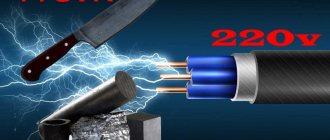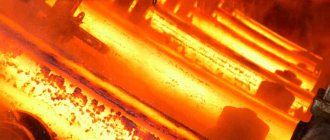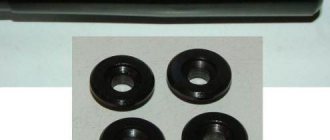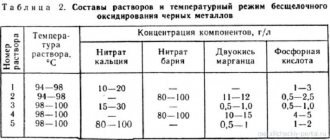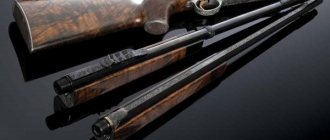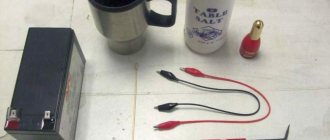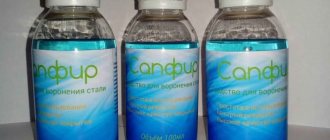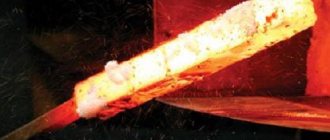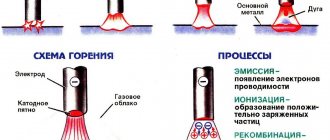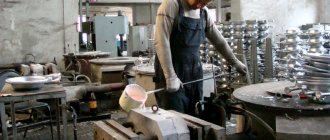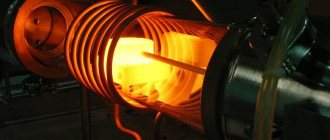Hardening defects
Hardening defects include:
- cracks,
- leashes or warping,
- decarbonization.
The main reason for cracks and cracks is an uneven change in the volume of the part when heated and, especially, during sudden cooling. Another reason is the increase in volume during martensite quenching.
Cracks arise because stresses due to uneven changes in volume in individual places of the part exceed the strength of the metal in these places.
The best way to reduce stress is to cool slowly around the martensitic transformation temperature. When designing parts, it is necessary to take into account that the presence of sharp corners and sudden changes in cross-section increases internal stress during hardening.
Warping (or warping) also arises from stress as a result of uneven cooling and manifests itself in the curvature of parts. If these distortions are small, they can be corrected, for example, by grinding. Cracks and warping can be prevented by preliminary annealing of parts, uniform and gradual heating of them, as well as the use of stepwise and isothermal hardening.
Decarburization of steel from the surface is the result of carbon burnout during high and prolonged heating of the part in an oxidizing environment. To prevent decarburization, parts are heated in a reducing or neutral environment (reducing flame, muffle furnaces, heating in liquid media).
The formation of scale on the surface of the product leads to waste of the metal and deformation. This reduces thermal conductivity and, therefore, reduces the rate of heating of the product in the furnace and complicates mechanical processing. Scale is removed either mechanically or chemically (etching).
Carbon burned from the surface of the metal makes the product decarbonized with reduced strength characteristics and difficult machining. The intensity with which oxidation and decarburization occurs depends on the heating temperature, i.e., the greater the heating, the faster the processes occur.
The formation of scale during heating can be avoided if a paste is used for hardening, consisting of liquid glass - 100 g, refractory clay - 75 g, graphite - 25 g, borax - 14 g, carborundum - 30 g, water - 100 g. The paste is applied to the product and allow it to dry, then heat the product in the usual way. After hardening, it is washed in a hot soda solution. To prevent the formation of scale on high-speed steel tools, a borax coating is used. To do this, the instrument heated to 850°C is immersed in a saturated aqueous solution or borax powder.
Heat treatment: how best to harden iron at home
This is a heating process followed by further cooling to change properties. We place a regular alloy in the furnace, and take out a hardened one, which is less susceptible to external deformations. What is it for? During primary processing, for example during stamping, cutting or casting, internal stresses appear inside the alloy, which have a very negative effect on the strength characteristics and increase brittleness. There are four types of heat treatment:
- Annealing. Necessary for the formation of ferrite and pearlite. It consists of heating in a furnace to 680-740 degrees, when the recrystallization threshold has already passed. As a result, old molecular bonds break down and new ones form. Then follows some exposure at a temperature of 400-500, at the end - cooling, slow, together with the heating element and simply open doors.
- Normalization is similar to the procedure for relieving internal stress, but heating is higher and cooling is much faster.
- Hardening. The main process that occurs is a change in grain size, which leads to the desired results. Cooling is very rapid, often in water or oil.
- Vacation. It comes in several modes. Let's talk about it separately.
Requirements for the hardening chamber
The main thing in the forge is the choice of bricks from the right material. They must be made of fireproof clay. This is the key to long-term operation of the entire structure. If you plan to harden long knives, you can make a forge of one and a half or two bricks.
When choosing a propane burner, you should pay attention to the presence of a control valve. This will allow you to select the optimal temperature regime based on the size and type of knife
The hole for the heating chamber can be made with a regular drill. Refractory materials are not very hard, so this procedure does not take much time. In addition, it is necessary to make a side hole for the burner flame. It should be remembered that the nozzle should be located at a distance of 2-3 cm from the edge of the brick.
With this design, you can quickly and conveniently heat small knives. Alternative heat sources will be discussed below.
Properties of metal after processing
After carburization, the hardness of the carburized layer reaches: 58-61 HRC on alloy steels and 60-64 HRC on low-carbon steels. Prolonged exposure of steel to high temperatures causes a change in the structure of the metal.
Steel structure after carburization
To correct large grains of metal, parts after carburization are subjected to reheating and hardening, followed by tempering or normalization.
Hardening is carried out at a temperature not exceeding 900C. In the metal, grain refinement occurs due to the production of pearlite and ferrite.
Instead of hardening, alloy steels are subject to normalization. After through heating, martensite forms in the middle of the part. The heating of the part depends on the grade of steel from which it was made.
Heat treatment modes for steel after carburization
The final phase is low-temperature tempering, which eliminates surface stresses and deformations caused by high-temperature treatment.
Steel cementation at home: what it is and how to do it
The carburization process is based on the principle of chemical and thermal treatment of metal. The whole point of the procedure is to saturate the steel surface with the required amount of carbon under certain temperature conditions.
Several years ago, this procedure was almost impossible to implement at home. Today this is possible using graphite media or their analogues. The main thing is desire and some knowledge.
The first step is to understand the basics of heat treating steel.
The features of metal carburization include the following factors:
Thanks to the procedure, case-hardened steels become stronger, which increases the wear resistance and strength of the material; The operating properties of the metal are changed by heating the products in a liquid, gas or solid medium, which improves its characteristics; Parts can be heated to different temperatures; there is no limited constant or exact recommendations. At home, the cementation process takes place at a temperature of 500 degrees Celsius. In industrial conditions using professional equipment, the heating temperature in the furnace reaches more than 1300 degrees Celsius. You should know that the temperature is chosen taking into account the concentration of impurities and carbon. Professionals recommend cementing low-carbon types of steel (approximately 0.2%) at home. For example, a blade from an inexpensive kitchen knife made of steel or small parts. Carbon penetrates into the structure of steel rather slowly. Therefore, cementation of the knife blade in a home procedure occurs at a rate of no more than 0.1 ml per hour. In order for the same blade to withstand heavier loads, it is necessary to strengthen the layer with a thickness of up to 0.8 ml per hour
It is also important to understand that carburizing a knife or small shaft in a home workshop will take at least eight hours. In this case, you should maintain a certain temperature in the oven so as not to disturb the temperature regime. During the process of carburization, not only the property of the metal changes, but also its phase composition and atomic lattice
In general, the surface obtains the same characteristics as when hardened, but it is possible to control it over a narrow temperature range in order to avoid various material defects.
Carburizing stainless steel is a little more difficult, but at the same time it will qualitatively improve the characteristics of this type of metal.
Case hardened steels using gas
For the first time, steel cementation with gas was carried out at the Zlatousovsky plant under the vigilant leadership of P. Anosov. This effective method was developed by V. Prosvirin, S. Ilyinsky and N. Minkevich.
The essence of the process is quite simple - the metal is cemented under the influence of carbon-containing gas (natural, artificial or generator) in a hermetically sealed furnace.
The most accessible and frequently used gas is a composition obtained from the decomposition of petroleum products.
It is made in the following way:
- Kerosene is poured into a special steel container and heated until the process of pyrolysis occurs - the decomposition of kerosene into a mixture of several gases;
- approximately 60% of this gas is modified and made suitable for cementation.
A mixture of modified gas and pure pyrolysis gas is used for cementation. The need to modify part of the gas is due to the fact that the use of pure pyrolysis gas on steel results in insufficient carburization, and a little soot may settle on some parts, which is difficult to remove.
The process of carburizing steel with gas is carried out in special continuous conveyor furnaces. Or they use unique stationary units.
First, the part is placed in the furnace, its muffle. The installation is closed and the furnace is heated to 950 degrees. Then pre-prepared gas is supplied.
It is almost impossible to carry out this procedure at home.
At the same time, it has several advantages over the solid processing method:
- less time is spent on preparing raw materials for cementation;
- more favorable and safe working conditions for workers;
- acceleration of the hardening process by reducing the holding time of products.
The most important thing when carburizing steel is a well-organized process and high-quality equipment and raw materials. The solid method can be implemented at home if you have a stove, carburizer and metal molds
As well as certain skills and abilities associated with this steel hardening process.
Do-it-yourself steel cementation process
When setting up a chemical-thermal treatment process at home, the method of cementation in a solid medium is chosen. This is due to a significant simplification of the task of equipping the premises. Typically, a solid carburizer is made using a mixture of barium or calcium with charcoal, as well as sodium carbonate. The salt is ground to a powder and then passed through a sieve.
Cementation of steel in a solid carburizer
Recommendations for creating a solid mixture are as follows:
- The first method is to use salt and charcoal, which are mixed thoroughly. If you do not use a homogeneous mixture, then there is a possibility of the formation of stains with a low carbon concentration.
- The second method involves the use of charcoal, which is poured on top with salt dissolved in water. After this, the coal is dried to obtain a mixture with a moisture content of about 7%.
For knives and other products, the second method of producing carburizer is most suitable, since it allows you to obtain a uniform mixture. Cementing steel at home with graphite also involves creating a mixture using several technologies.
Cementation is carried out in special boxes, which are filled with prepared carburizers. The structure must be airtight, for which the cracks are sealed with clay. It is recommended to achieve high tightness due to the fact that when the carburizer is heated, gases are released that should not enter the environment. The box itself should be made of heat-resistant steel that will withstand high temperatures.
The process of carburizing steel in a box at home has the following features:
- The part is placed in a box with the mixture. The thickness of the solid carburizer layer is selected depending on the size of the workpiece.
- The stove is being installed.
- The initial heating of the furnace is carried out to a temperature of 700 degrees Celsius. This heating is called through heating. The uniform color of the steel from which the box is made indicates the possibility of moving on to the next stage.
- The next step is to heat the medium to the required temperature. It is important to ensure uniform heating of the surface of parts with complex shapes, since significant problems may arise if the atomic structure is unevenly rearranged.
Cementing steel in a box at home
Today it is possible to carry out a similar procedure at home, but difficulties arise in achieving the required temperature.
The lack of necessary equipment leads to a significant decrease in the quality of the resulting products, as well as an increase in holding time.
Structural changes in metal
When nitrogen and carbon atoms are introduced into the surface layer of the metal, some changes occur. During nitrocyanation, the ratio of the residual amount of austenites and fine-crystalline martensites in the surface layer changes, a small amount of a solid solution of carbonitrides is added, which affects the mechanical properties - hardness and wear resistance.
At the same time, fragility increases slightly and fatigue and contact strength decreases. This quality is especially evident in alloy steel with a nickel content of more than 1.2%. Thus, not all brands can be processed using this method. Reducing the grain size of the structure is achieved by additional hardening and tempering immediately after the nitrocarburization process. Steel treated in this way has a smaller grain size than cemented steel, which increases its bending strength while reducing the thickness of the treated layer.
Nitrocarburization significantly changes the characteristics of the thin outer layer of metal, its hardness and wear resistance. After additional heat treatment - hardening, the hardness of the surface layer on the Rockwell scale is 58-64 HRC or 500 - 1000 HV according to the Vickers method. Using low-temperature carburization, it is possible to obtain a thin surface layer with a hardness of 5000 – 11000 HV.
Cementation of metal in a solid medium
fractions measuring about 3-10 mm
To create a mixture, two main methods can be used:
- The main components are dry salt and coal, which must be thoroughly mixed with each other, thereby minimizing the risk of staining during chemical-thermal treatment of steel;
- Salt, previously mixed with water, must be poured onto the prepared charcoal until dissolved. Next, the mass created on the basis of these components must be placed for drying, and it is optimal when the moisture content of the mixture does not exceed 7%.
Of these methods, the second is the most preferable due to its higher quality. This is manifested in the fact that it can be used to create a more uniform mixture to saturate the surface with carbon. In the composition of the finished carburizer, charcoal accounts for about 70-90%, and the rest is taken up by calcium carbonate and barium carbonate.
To carry out solid carburization, boxes are used where the carburizer is placed. It is best to use a box that matches the shape of the items being processed. The fact is that this will help improve the quality of the cemented layer, while it will be possible to reduce to a minimum the time required to warm up the container
It is important to ensure that there are no gas leaks: this problem is solved by covering the boxes with clay and then covering them with airtight lids.
An important point is that resorting to the considered option of creating specially shaped containers for direct use makes sense in cases where it is necessary to process a large number of parts using the chemical-thermal method. The most widely used boxes are those that have a standard shape and differ in geometric dimensions. This makes it possible to select the most optimal option from them, which takes into account to the greatest extent the number of processed products and the dimensions of the furnace.
Typically, boxes are made from low-carbon or heat-resistant steel. Moreover, when processing parts using a solid carburizer, adhere to the following scheme:
- Parts that need to be saturated with carbon should be placed alternately in a box filled with a pre-prepared mixture;
- Next, prepare the oven for work, for which it is heated to a temperature of 900-950 degrees, then the work container is placed there;
- The operation itself to warm up the box is performed at a temperature of 700 to 800 degrees. You can determine that the boxes have warmed up sufficiently by looking at the hearth plate, which should have a uniform color;
- At the final stage, the oven temperature is increased to 900-950 degrees Celsius.
The creation of the specified temperature regime provides conditions for the penetration of diffusion into the crystalline structure of the metal of active carbon. Theoretically, this method can also be used for chemical-thermal treatment of buildings, and individual craftsmen are able to cope with this task on their own. However, in terms of efficiency, such treatment carried out at home is characterized by rather low efficiency, the reason for which is the long processing time and the need to create a high temperature regime.
Liquid cementation
Liquid cementation is performed in molten salts, usually salts consisting of alkali metal carbonates. This mixture is melted in a bath and carburization is carried out by immersing the parts in the melt. The process is carried out at 850°C for 0.5 - 3.0 hours, while the milking depth is within 0.2 - 0.5 mm. The main advantage of the process is the possibility of direct hardening from a carburization bath and small deformations of the processed products. In conditions of individual and small-scale production, cementation from pastes has found some application. In this case, a coating containing soot (33–70%), wood dust (20–60%), yellow blood salt (5–20%) and other components is applied to the treated surface. Organic, organomineral and inorganic adhesives are used as binding materials. The thickness of the coating should be 6–8 times greater than the required thickness of the cemented layer.
Currently, the most promising cementation method is carburization in an endothermic atmosphere with controlled carbon potential. During gas cementation in an endothermic atmosphere, at the beginning of the process (during the active period of saturation), a high carbon potential of the atmosphere is maintained by adding unprocessed hydrocarbon gas (methane or propane-butane) to the endothermic atmosphere. During the diffusion period, the carbon potential of the atmosphere is set to 0.8 - 1.0% and the amount of added hydrocarbon gas decreases sharply.
Nitriding of steel
When nitriding, the surface layer of a steel part is saturated with oxygen. This method received industrial application almost 100 years ago, in the 20s of the 20th century. Nitriding a part is an excellent way to increase not only the hardness of the product, but also its corrosion resistance.
Nitriding of steel is carried out by immersing the part in furnaces, which are hermetically sealed. Ammonia is supplied there, which, when heated, breaks down into nitrogen and hydrogen. During this reaction, nitrogen atoms are absorbed by the steel surface layer and penetrate into the part.
It is difficult to say how deep and durable the layer subject to nitriding will be. This factor depends on many details:
- temperature at which nitriding was carried out;
- duration of part processing;
- composition of steel that has been nitrided.
Chemical-thermal treatment method
The described procedure does not allow achieving several goals simultaneously, unlike cementation. There are two types of nitriding.
Increasing the strength of the surface layer of a steel part. The process temperature is up to 560 °C, the average layer thickness is 0.5 mm. The duration of the operation can reach one day.
Increased corrosion resistance. The optimal temperature is from 650 to 700 °C. Anti-corrosion nitriding can continue for up to 10 hours. The thickness of the layer formed in the process is 0.3 mm.
The steel nitriding process can only be carried out on fully finished products that have gone through the stages of heat and mechanical treatment. The structure of sorbitol inside the product is completely preserved, which increases the strength and toughness of the part.
Gas cementation
In mechanical engineering, the technology of saturating the top layer of steel products with carbon in an atmosphere of carbon-containing gases is widespread. It is known that such production is convenient for mass processing of parts, since:
- Adjustment of gas density is allowed; thereby forming a carbon layer with the desired properties.
- The full heat treatment cycle (cementation, hardening, washing and tempering) takes place in one place - in a shaft (cementation) furnace.
- The process is economical, mechanized and automated.
- Boxes with a carburizer do not require heating, which reduces the time of carburization.
- The rate of carburization of parts increases by 2–3 times (compared with other methods), and the uniformity of the layer is higher.
- The temperature of the gas mixture of hydrocarbons (methane and carbon monoxide) is adjusted to 900-950°C.
- After carburization, the technological chain is completed by tempering (hardening).
Hardening the cutting edge of a knife
We take a knife.
We go along the edge with a file, while paying attention to the dull sound and slight grinding of the metal. Everything indicates that the knife is made of ordinary steel and has not been previously hardened
For hardening you need graphite. It is best to obtain graphite from graphite brushes of a generator or brushed electric motor. Of course, I haven’t tried it, but you can also get graphite rods from AA batteries or simple pencils. In general, we grind this graphite into powder in any way. There is no need to grind it too much, without fanaticism.
Next, I need a metal base on which the graphite powder will lie. I took a piece of galvanized drywall profile.
The knife edge hardening process also requires a power source. Ideally, this is a pulsed DC welding machine set to minimum. You can also try to repeat the process using another source, 30-60 volts AC or DC. There is another dangerous option: using a 220 V network directly, in series with an incandescent lamp, but this is already fraught, so I do not recommend it.
Pour in graphite. We connect the plus of the welding machine to the base of the substrate, and the minus to the knife. We set the inverter to minimum settings and turn it on. We begin the process of hardening the edge. To do this, very carefully run the edge of the knife along the graphite pile. Our task is: first, to prevent the blade from touching the base. And the second thing is to prevent the graphite from burning. In both cases the blade will be damaged.
Ideally, the blade should be moved slowly, and the graphite should sparkle and flicker. Naturally, you don’t need to lower the knife too much. As soon as you notice the contact area heating up, immediately lift the knife.
The whole process does not last long, about 5 minutes. During this time I managed to walk along the entire length of the blade several times.
Graphite hardening
Graphite cementation is a very simple but effective way of surface hardening a knife with your own hands, which is best suited for strengthening some part of the blade.
To do this, you will need graphite, which can be obtained from simple AA batteries. You need a metal platform on which the hardening process will take place. A simple profile, which is used when working with drywall and other finishing work, is good for this.
We will also need a constant power source. An excellent option would be a welding machine, the power of which should be set to the minimum level. If this is not the case, you can try a similar option that will be able to provide you with about 50 volts of DC voltage. I strongly do not recommend using a 220 volt network.
Any instructions, including those for properly hardening knives, must begin with preparation. Once you have all the necessary components, you need to prepare your workspace.
We take the profile, pour our graphite onto it, it should turn out to be a small mound. You need to connect the positive cable of the power supply to the profile, but the negative cable needs to be connected to the knife.
- What to give your beloved husband something unusual for his birthday. List of ideas + video
- Radon baths: indications and contraindications, reviews from doctors, benefits and harms, rules of administration
- An original birthday gift for dad: interesting examples with the best design + video tips
This method is good for hardening the edge, which gradually comes into contact with graphite. To do this, after everything has been done above, you need to turn on the power source and apply voltage to our parts. The knife must be gradually drawn along the graphite with the edge of the blade.
When this happens, rest assured that you will see the hardening process in person. This needs to be done gradually and carefully. If you touch the profile, the process is ruined. If you keep the edge in graphite for a long time, it will catch fire and the hardening will be ruined again. In both situations, the blade will be damaged beyond repair.
It is correct to conduct hardening with slow, gradual and short movements. Visually, it is very clearly noticeable when graphite begins to heat up strongly and spark. When you see this, you need to raise the knife. The blade should not be dipped very deeply into graphite; it is best to do this only with the cutting edge.
For a small knife you will need about five minutes to harden its edge. This process is delayed precisely due to the burning of graphite, which must always be avoided. As you can see, there is nothing complicated in this process, you just need to follow the instructions and work carefully.
General information about the process
The first step is to understand the basics of heat treating steel.
The features of metal carburization include the following factors:
Thanks to the procedure, case-hardened steels become stronger, which increases the wear resistance and strength of the material; The operating properties of the metal are changed by heating the products in a liquid, gas or solid medium, which improves its characteristics; Parts can be heated to different temperatures; there is no limited constant or exact recommendations. At home, the cementation process takes place at a temperature of 500 degrees Celsius. In industrial conditions using professional equipment, the heating temperature in the furnace reaches more than 1300 degrees Celsius. You should know that the temperature is chosen taking into account the concentration of impurities and carbon. Professionals recommend cementing low-carbon types of steel (approximately 0.2%) at home. For example, a blade from an inexpensive kitchen knife made of steel or small parts. Carbon penetrates into the structure of steel rather slowly. Therefore, cementation of the knife blade in a home procedure occurs at a rate of no more than 0.1 ml per hour. In order for the same blade to withstand heavier loads, it is necessary to strengthen the layer with a thickness of up to 0.8 ml per hour
It is also important to understand that carburizing a knife or small shaft in a home workshop will take at least eight hours. In this case, you should maintain a certain temperature in the oven so as not to disturb the temperature regime. During the process of carburization, not only the property of the metal changes, but also its phase composition and atomic lattice
In general, the surface obtains the same characteristics as when hardened, but it is possible to control it over a narrow temperature range in order to avoid various material defects.
Carburizing stainless steel is a little more difficult, but at the same time it will qualitatively improve the characteristics of this type of metal.
Classification of the environment in which steel carburization takes place
Carburization of a knife or other product can take place in the following environments:
- Solid.
- Gas.
- In the form of a paste.
- Electrolyte solution.
- Fluidized bed.
Cementation of metal at home with graphite is most often carried out. The most widespread is the solid medium due to the fact that it is not necessary to ensure high tightness of the furnace.
Gas is used primarily in industrial production, as it allows achieving the required results in a minimum period.
Uniform heating
Using this technique will require repeated use of coolant, so you need not one container, but several. The whole process is based on uniform heating of the workpiece in the furnace. If you periodically dip a part into oil, it will heat up over time, so you will have to change the container. After completely heating to the required temperature, you need to suddenly place the product in the oil to cool it as quickly as possible.
It was repeatedly noticed that during the heating process, the hardened workpiece noticeably changes color; temperatures were measured during the process, which led to certain conclusions. The longer the workpiece is heated, the higher its temperature, and in the color scheme this was expressed as the acquisition of a lighter shade. At the moment when the metal had a red-brown color, the temperature of the workpiece was approximately 530-580 degrees, then its shade turned into burgundy, and the temperature readings were 650-720 degrees. Over time, the burgundy turned into red; measurements already show results of 720-950 degrees. And only after the 950 mark did the metal begin to acquire a bright orange hue.
These measurements help to extract another trick that will undoubtedly help the home craftsman during hardening, especially if he has not had such experience before.
It is also worth noting that when using steel containing chromium, the heating temperature changes more slowly. Therefore, to achieve the same results, you will have to spend a little more effort and time.
How to harden knife steel
Having chosen high-quality steel, the only thing left to do is small, but no less important - to properly heat treat the metal.
When starting to make a knife at home, you should know the main points and rules of how to harden steel for a knife, following which you will be able to achieve maximum results.
The hardening procedure is a mandatory step in the manufacture of a product. It should be started after the blade has been given the desired shape during the annealing process. This manipulation is intended to reduce the hardness of the part so that the sketch of the future blade can be followed. However, the knife must not only be beautiful, but also hard and durable if it is intended to be used. This is where hardening the metal for a knife comes to the rescue.
This procedure begins by bringing the desired samples to the required temperature. As already mentioned, the temperature depends on the type and grade of steel, but on average we can give a figure of 700°C. Warming up should be done evenly along the entire length of the product. Uneven heating, along with sudden cooling, can cause various defects and cause warping of steel. The color of the steel will tell you whether the surface has warmed up to the required temperature and whether it can be removed to perform the next step.
The cherry-red and scarlet color of the metal will indicate the acquisition of a temperature ranging from 730 to 800°C. Approaching light shades of yellow indicates that the temperature has gone off scale beyond 1100°C. With white color there was a clear overshoot, since it shows a value above 1300°C.
If the part is overheated, it will be hopelessly damaged (it will become irreversibly brittle and brittle, and may simply crumble) and you will have to start all over again. If the steel is underheated, the product will turn out to be soft and bend easily, but in this case, if you repeat the procedure correctly, everything can be corrected. Such hardening will increase the hardness of the part by 3–4 times.
Once a metal blade has been hardened, it becomes very hard, but at the same time brittle. This is an unacceptable situation for a knife. Therefore, there is the next stage aimed at returning strength to the blade (which many call the priority quality in knives) - tempering.
It involves repeated heating of the metal followed by slow cooling. This can be either a natural process (cooling in air) or dipping in water or quenching oils (this depends on the type, brand, shape of the steel). In some cases, the technology of alternate dipping into different media is used: both water and oil. In this case, pure water will not work (it can cause cracks); you should add salt to it, for example. This manipulation will return not only strength to the parts, but also toughness, and will relieve internal stress in the alloy.
To temper, the product must be hardened again, but now not to a critical temperature, but to one that is suitable for a particular product. There are 3 types of vacation:
- low temperature - heating to 250°C, which will give the part good wear resistance, but will make it unsuitable for heavy power loads. Essentially an ideal option for a knife blade;
- medium temperature - temperature ranges from 350 to 500°C. This is an option for dies, springs;
- high temperature – from 500 to 680°C. This is how parts that are subject to shock loads (shafts) are heated.
The temperature will again be shown by the product itself due to the tarnished color (for a knife, light yellow is optimal). This is due to the formation of an oxide film that needs to be cleaned off. After cleaning from the hardening products, the tempering itself can be carried out. In liquid it will take a couple of seconds. In the air - a couple of hours.
Cyanidation of steel
This process is somewhat different from carburization and consists in the fact that the surface layer of the steel element is saturated not only with carbon, but also with nitrogen. In industry, high- and low-temperature cyanidation is used, while carburization does not allow several types of operations.
High temperature cyanidation
The main objective of this process is to make the part harder and more wear-resistant. The manipulation is carried out in baths that are filled with neutral salts: BaCl2, NaCl, Na2CO3 and some others. The role of carburizers is performed by KCN and NaCN salts, the active ingredient of which is cyanogen. It contributes to the fact that the steel part is saturated with nitrogen and carbon. The process is carried out at temperatures up to 900 °C.
In order for the cyanidated layer to become as durable as possible, the parts are hardened either in oil or in water for one and a half hours. To prevent the amount of cyanide from decreasing (it gradually burns out), small portions of cyanide salts are added to the bath.
Low temperature cyanidation
This process is appropriate if the part must meet the criteria of increased strength and wear resistance. The temperature required to achieve these goals ranges from 550 to 570 °C (high-speed steel) and 510–520 °C (high-chromium steel).
The procedure is carried out in a salt bath, the contents of which are equal parts of NaCN and KCN. The depth of the resulting layer is from 0.01 mm (with a cyanidation duration of 10 minutes) to 0.06 mm (with a process duration of up to 60 minutes).
Advantages and disadvantages of nitrocarburization
Among the advantages of nitrocarburization, one can note the high technological effectiveness of the process, simplicity and convenience of adjusting parameters. By selecting the temperature regime, the composition of the gas mixture and, in particular, the processing time, you can easily adjust the thickness of the saturated layer depending on the requirements. The low processing temperature reduces the risk of product deformation and simplifies further hardening, since only minimal time is needed to reduce the temperature of the workpiece. Thus, the technological cycle time for production of products is reduced. The processed products have high surface quality and excellent physical and mechanical properties. In low-alloy steels, after treatment, an increase in corrosion resistance is observed.
Microstructure of nitro-carburized layers
Among the many useful properties, we must not forget that this metal processing technique also has disadvantages. The most significant disadvantage of this type of nitrocarburization, such as cyanidation, is the high toxicity of the production components. To saturate with nitrogen and carbon, sodium and calcium cyanide salts, which are extremely toxic substances, are used.
A less significant drawback, which is insignificant in many areas of application, is the slightly increased fragility of the metal after processing. But since the changes affect only a relatively thin layer, this characteristic is insignificant and is offset by the increased resistance of the material to wear.
When producing parts that require cyanidation and subsequent hardening, it is necessary to strictly observe the sequence and timing of the parts of the technological process. Thus, hardening should be carried out immediately after the end of the saturation process, since reheating the workpiece will lead to the outflow of nitrogen molecules from the treated surface. The reduction in nitrogen concentration can be up to 60%.
As already mentioned, low processing temperatures make it possible to combine several types of processing in a single process. After completion of the saturation process, the parts require a short cooling time for further quenching in oil. Thus, oil hardening can be done directly in a nitrocarburization furnace.
All types of nitrocarburization, by accelerating the saturation of steel with carbon compared to carburization, provide an advantage in processing time of up to 50-60%. Thus, the main benefits of nitrocarburization are reduced production time with minimal risk of negative impact on part geometry. At the same time, performance is improved due to the presence of nitrogen.
The composition of the gas mixture is quite simple to regulate both before and during processing. The heating time of the process components is significantly reduced, since the gas supplied to the chamber may already have the required temperature.
https://youtube.com/watch?v=bnkTUowNHkM
Since the processes of nitrocarburization and carburization are technologically very similar, the same equipment can be used for them, which greatly facilitates the transition to a different range of products or changes in production technology.
Gas Application
In mass production, a gaseous environment is used. Surface saturation with carbon can only be carried out using a sealed oven. The most common composition of the gas environment is the substances obtained from the decomposition of petroleum products.
Gas carburization of steel
The procedure has the following features:
- Continuous conveyor ovens with increased isolation of the working environment should be used. They are very rarely installed at home due to their high cost.
- The workpieces are placed in the furnace, after which the medium is heated to the required temperature.
- After heating the furnace to the required temperature, gas is supplied.
There are quite a lot of advantages of this technology:
- There is no need for lengthy preparation of the gas environment.
- The process involves short holding times, which reduces the cost of maintaining temperature.
- The equipment is compact and does not take up much space.
However, there is a significant drawback, which is the inability to install equipment and set up the process at home. The profitability of cementation at home when installing such equipment is ensured only with a significant increase in the batches processed.
If you find an error, please select a piece of text and press Ctrl+Enter.
Topic: how to harden a knife yourself using electric current.
It is known that metal can be hardened, this gives it additional strength. Hardening involves heating the metal to a certain temperature and then cooling it. This process changes the internal structure of the metal, making it stronger. Although at the same time the metal loses another of its properties, namely flexibility and ductility. Here the choice is yours: what do you need from the metal, its increased strength (but at the same time fragility increases) or flexibility (stiffness decreases).
The classic method of hardening metals is conventional heat treatment in flames, hot coals, gas furnaces, etc. But the temperature can also be increased due to electric current. Hardening is done uniformly. To ensure this, there is one interesting way using graphite powder. As you know, graphite conducts electricity quite well, in addition to this it is resistant to high temperatures. It is these two qualities of graphite that make it possible to harden metal with electric current using graphite powder.
I decided to try electrically hardening a small metal knife (homemade) and organized the following. So, I needed a power source, graphite powder, wires of sufficient cross-section, a metal substrate, and a small knife itself. As a power supply, I used a regular step-down transformer taken from an old color TV. Its primary winding is designed for a voltage of 220 volts, and I rewound the secondary winding to a voltage of 80 volts (in the end this turned out to be not enough, about 100 volts are needed).
To harden metal with electric current, sufficient current is needed. The cross-section of the secondary winding on my transformer was about 1.5 mm. But for larger knives it is better to have a larger cross-section. Next, I took a metal substrate onto which I poured graphite powder. You can make the powder yourself from a piece of graphite (grind off any graphite brush from an electric motor with a large file). I connected one of the wires coming from the secondary winding of the transformer to this substrate. I connected the second wire to the knife itself, which I hardened. The cross-section of these wires must also be at least 1.5 mm.
The electric hardening of the knife itself was done as follows:
Having applied voltage to the transformer, I took a knife and carefully began to move its tip along the graphite powder. Many small sparks began to jump between the tip of the knife and the graphite powder, indicating electrical contact in the circuit
I also made sure that while driving the knife through the graphite powder, I did not have the knife in direct contact with the metal substrate. Such contact would create a short circuit. Nothing particularly terrible would happen here, but it’s better not to allow it. As a result, the tip of the knife gradually warmed up. This was proof that this method of hardening metal works fine if everything is done correctly.
https://youtube.com/watch?v=ss300MaHZXM
Features of the technology
At home, if you approach the matter correctly, you can qualitatively harden any knife. This could be a hunting or folding knife, a bayonet-knife or a product in the form of a hook, a blade made of a file or a bearing, a butterfly knife, etc. It is somewhat more difficult to harden products made from stainless steel at home, but this problem can be solved, if you carefully study the process technology and select the appropriate heating equipment.
Various materials are used as a cooling medium when performing hardening, both in production and at home. Thus, the most common cooling media - water and oil - provide the following cooling rates of a heated steel product:
- oil at room temperature – 150°/s;
- oil heated to a temperature of 200° – 300°/s;
- water, the temperature of which is slightly above 20°, – 450°/s;
- ice water – 600°/s.
In some cases, hardening is performed by cooling the product in an intermediate medium, which can be molten lead. This technique, in particular, is used when hardening knives that are made from files.
Annealing a knife over an open fire requires close attention.
The most important problem that you may encounter when trying to harden a knife at home is overheating the metal, which leads to a significant increase in its fragility. It is also necessary to very carefully monitor the uniform heating of the knife being hardened, so as not to encounter the formation of transverse cracks on its blade.
There is a simple rule that should be followed in order not to encounter such a problem: the part of the blade that will not be sharpened is heated three times to a purple color, which corresponds to a temperature of 285 °, and the cutting part is heated only once to a yellow color, after which the degree Its heating is checked using a magnet. You can learn more about this technique by watching the corresponding video.
Colors of heat and tarnish of carbon and low-alloy steels
On stainless steels, tarnish colors appear in the same sequence, but at higher temperatures
Different cooling media also provide different depths of the hardened layer (hardenability). Thus, when cooled with water, steel is calcined at a rate of 1 mm per second, and when oil is used as a cooling medium, this rate is almost halved. To harden a double-edged knife, obtaining hard cutting edges and an elastic core, you need to do the following: the blade, heated to the required temperature, is first dipped in water for two seconds and then placed in oil.
Another technology that allows you to qualitatively harden the cutting edge of a blade with significant thickness is hardening the knife in graphite. Using this technology, the details of which can also be easily studied in the video, you can qualitatively harden knives of various models and configurations (hunting knife, bayonet knife, butterfly knife, etc.). At the same time, such hardening can be performed efficiently at home.
Homemade knife after hardening in graphite
It is often necessary to carry out zone tempering of an already hardened knife in order to make its middle part more elastic, while maintaining the hardness of the cutting blades. At home, such a technological operation is performed according to the algorithm below.
- The middle part of the blade is heated using a metal rod with a diameter of 10 mm, heated to maximum.
- After heating the middle part of the blade, it is dipped in boiling water and kept in it for 2 hours.
- After soaking in boiling water, the blade is dipped into ice water.
After completing all the manipulations described above, you will receive a knife whose middle part of the blade has been subjected to low tempering.
You can determine the tempering temperature by the colors of tarnish - a rainbow film that appears when the cleaned surface of the knife is heated: from light yellow (item 1) to bluish (item 6)
If you are trying to harden your knife at home, you should follow two rules that will allow you to get high-quality results.
- The volume of coolant used must be large enough (minimum 20 liters). Otherwise, the liquid will become very hot, which will change the temperature regime and cooling rate, and this in turn will negatively affect the result of the entire technological operation.
- In order for the heat transfer from the heated knife to be uniform and not to lead during the hardening process, it cannot be moved in the cooling environment - it must be kept motionless.
